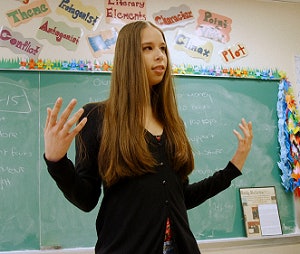I vividly remember the moment when I learned that I had been accepted by one of my top choice colleges.
I could not allow myself to celebrate. I was thrilled, but also dispirited.
Here was this amazing opportunity, yet I didn’t yet know if I would be able to afford it. I’m the daughter of working-class Dominican immigrants who would never be able to spend $65,000 annually to send me to college.
And I was almost entirely on my own in figuring this all out.
 Christine Rodriguez
Christine RodriguezMy sense of bewilderment back then reflects the broader challenges facing millions of teenagers who attend public high schools with few, if any, resources to help them navigate the path to college.
There’s been so much attention lately about the college admission scandal — rich parents trying to buy their undeserving children into prestigious colleges. But there’s a far bigger scandal that our leaders have long ignored: many high school seniors who deserve to attend college don’t have the advice and support that they need to get there.
Students who are trying to become the first in their family to attend college often don’t have anyone at home who can help. So it is especially critical for them to get the help they need at school.
But most low-income students attend schools that don’t have a single staff member dedicated to college guidance. Instead, school counselors, who perform many other essential roles, are responsible for college counseling. The average counselor to student ratio is 1 to 464 across the country. And school counselors say they can only spend 20 percent of their time on college counseling.
At my high school and so many others with students living in poverty, the few school counselors we had were often focused on addressing crises, so they were left with little time to do college and career planning.
Still, I knew I wanted to go to college, just like most of my peers in my Brooklyn high school. Somehow, we all implicitly knew that going to college was our best bet at improving our circumstances.
And it is: on average, college graduates make $1 million more over their lifetime than those who only graduate high school.
It makes sense that 83 percent of all high school students have college aspirations.
But still, there were far too many students in my school who believed that college was not attainable.
I know this because during my junior and senior years in high school, I worked as a peer college counselor in my school.
The film, Personal Statement, which we are screening on Capitol Hill this week, documents my experience working as a peer college counselor to help fill the college guidance gap in my school.
I was charged with getting every single student on my caseload into college.
This experience gave me an inside view into the barriers that keep so many low-income students from going to college.
Some of the most challenging students to help were the ones who had internalized the feeling that college was not for them. In fact, many felt that school in general was not for them.
I came to understand that this had something to do with how they were treated in school.
In my school, we had to pass through metal detectors every morning. Most public schools in New York City do not have scanners and a heavy police presence, but the ones with the highest percentage of black and Latino students do.
This is not just a problem in New York City. According to a recent report by the ACLU, 1.7 million students in the U.S. attend a school with a cop but no counselor.
We are also concerned about the need to simplify the financial aid application process and make college more affordable. After struggling to compile the information needed to apply for financial aid, so many of my peers have since dropped out of college because they still could not afford to attend.
That’s why, as part of our impact campaign for the film, we are collaborating with initiatives like The College Promise Campaign, which seeks to make college more accessible by covering tuition and fees and enabling students to complete their college degrees without the burden of unmanageable debt.
Unlike the privileged students we read about in the recent college admissions scandal, for low-income students of color, the road to college is not paved. We want to go to college, but we need more support to get there.
Only 9 percent of people in the lowest income quartile attain a bachelor’s degree by the time they turn 24, compared to 77 percent from the highest income quartile. We want to believe the American Dream is attainable for all, but how can we when what we really have is a birth lottery? We need to distribute resources more equitably, including allocating more funding for public education, targeting resources to the students who need them most, and making college affordable. The only way to truly have social mobility is to make college equally accessible to everyone.
Christine Rodriguez attends Eugene Lang College at The New School, where she is pursuing a degree in urban studies with a minor in ethnicity and race. She also serves at the Bushwick School for Social Justice as a college counselor. In addition, she is on a mayoral task force for school climate and disciple and is a leader of the Youth Power Project at Make the Road New York.















